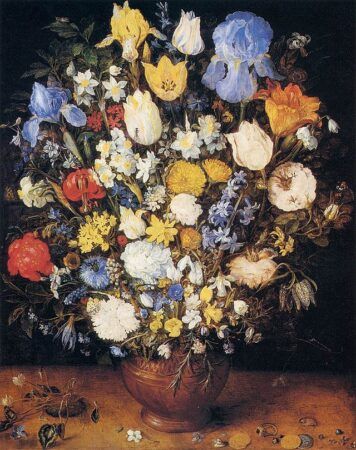Home News & Views A Bouquet in a Clay Vase: Reflections on a nursing career
A Bouquet in a Clay Vase: Reflections on a nursing career
Sue Hill, RBCS Project Manager and Facilitator
It’s funny what makes you reflect and for me, the ‘Bouquet in a Clay Vase’ by Jan Bruegel epitomises my nursing career as a whole and how I have learnt to tame my inner critic.
I began my training in 1980 as a student at Guy’s Hospital in London, part of the last cohort of State Registered Nurses who ultimately qualified in 1983. It was a time when the teaching methods were traditional; students wore hats, were told who they could interact with and spent most of their training on the ward rather than in a classroom. One of my unique skills from that time was learning how to care for flowers – patients received a lot of them in the 1980s! We were certainly trained, not educated in the conventional sense.
 This painting makes me reflect on my entire journey as a nurse. Each flower in the bouquet represents the different positions I’ve held, the chances I’ve taken, and the varied experiences I’ve had.
This painting makes me reflect on my entire journey as a nurse. Each flower in the bouquet represents the different positions I’ve held, the chances I’ve taken, and the varied experiences I’ve had.
I never had a specific career plan or pathway but, in retrospect, my career has been an eclectic and often incoherent mix—interesting, varied, and challenging. No piece has been mundane; instead, it’s been a vibrant, diverse journey full of colourful and unexpected moments.
Some of the roles I took didn’t lead anywhere, while others pushed me forward in my career. Some were side steps, and some were stepping stones that helped me become the knowledgeable professional I am today. This vase of flowers feels exactly like that—diverse, with various colours, textures, and assortments, each contributing to the overall beauty.
The Tulip – This represents my time as a District Nurse—bright, cheerful, full of energy, and always learning. During this period, I undertook my nursing degree and grasped every opportunity to develop myself further. The tulip is symbolic of the vibrancy and continual growth I experienced during this phase.
The Rose – The rose symbolises the highs and the lows of my career. While I had moments of significant achievement, there were also roles that didn’t suit me, where I quickly withered. In one particular role, I was once bright and multi-layered with knowledge, but the way I was treated caused me to fade, losing my shine, my enthusiasm, and, at one point, my passion for nursing.
The Flag Iris – The iris represents my final job in the NHS. I stood tall and proud in the midst of important healthcare moments, but post-pandemic, I started to fade. I realised I needed to change something in my life and retiring from the NHS was the way forward.
Facing the Inner Critic
In the middle of this picture, there seems to be a face. This face looking at me feels like my inner critic, often my very worst enemy. I will admit that my inner critic has influenced decisions I’ve made and things that I have done. It has sabotaged opportunities (I did a terrible interview for a job I really wanted), but has on occasion spurred me on (running a marathon aged 56)!
Paul Gilbert (2010), in his work on Compassion Focused Therapy, explains that constant self-criticism can trigger anxiety and anger, emotions linked to the brain’s threat system. He suggests that being kind to ourselves, showing compassion, and alleviating these feelings can make a profound difference. I found this approach to be a turning point in my journey.
Using positive reframing, as outlined by Stacey et al. (2017), I learned to identify my “limitations of influence” in situations beyond my control. This shift in perspective allowed me to curb negative thoughts and recognise my successes. Amy Morin’s words perfectly encapsulate this shift in my thinking: “When self-doubt creeps in, don’t ignore it – address it. Respond to harsh self-criticism with something more compassionate. Talk to yourself like a trusted friend and refuse to believe your unrealistic, negative inner monologue”.
What Now?
Three years after leaving the NHS, I am now working at FoNS; flourishing, strong, and feeling that I’m doing meaningful work (it’s a joy to work with social care nurses on the funded RBCS programme).
While my inner critic still makes occasional appearances, I’ve tamed it significantly and I have come to value my skills and what I can offer in the workplace. When I look at the Jan Bruegel painting now, the face representing my inner critic has faded, and more often than not, I simply see a flower – a symbol of my ongoing growth and resilience.
References
Gilbert, P. (2010) Compassion Focused Therapy. London: Routledge.
Morin, A. (2016) 5 Ways to Banish the Belief that you’re Not Good Enough.
Stacey, G., Aubeeluck, A., Cook, G. and Dutta, S. (2017) A case study exploring the experience of resilience-based clinical supervision and its influence on care towards self and others among student nurses. International Practice Development Journal; 7(2): 1-16.
Comments are closed.


